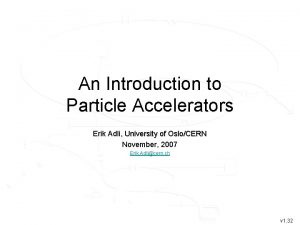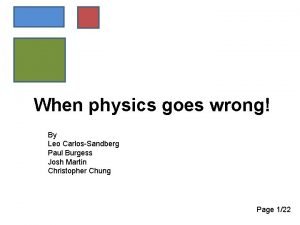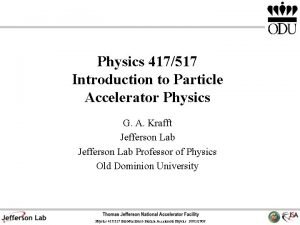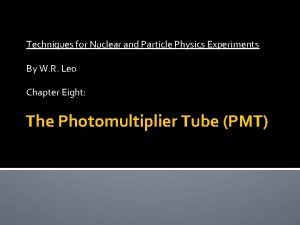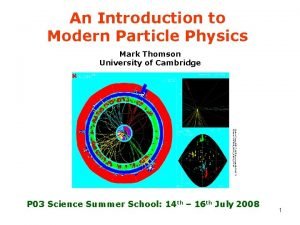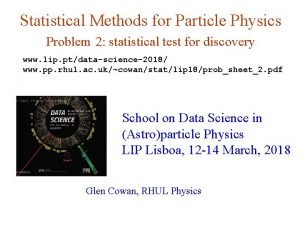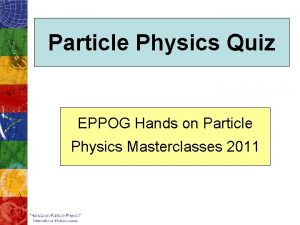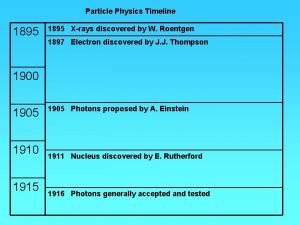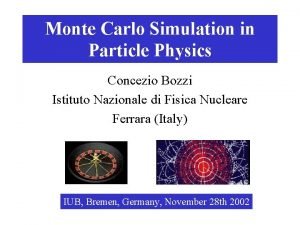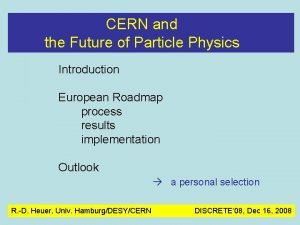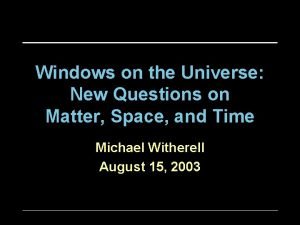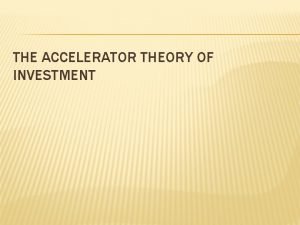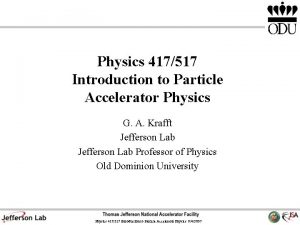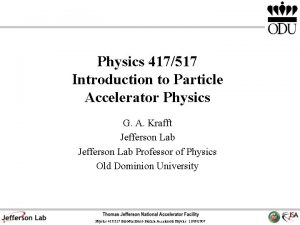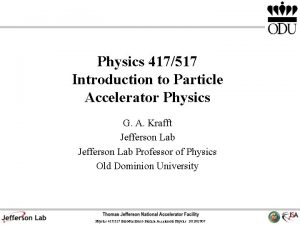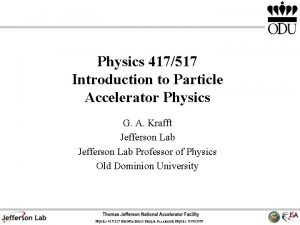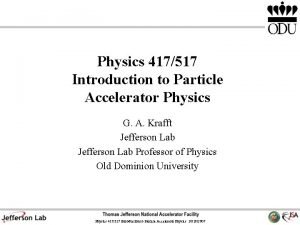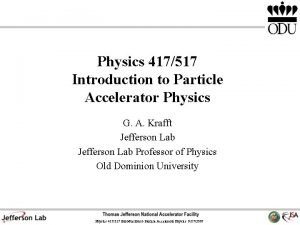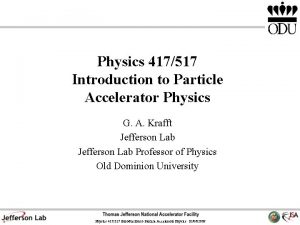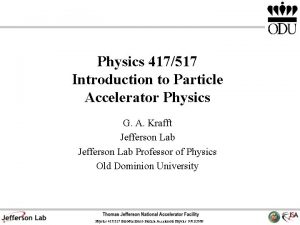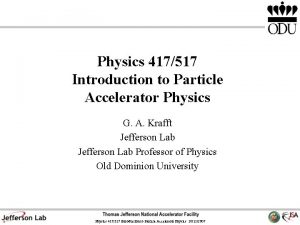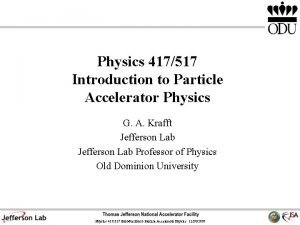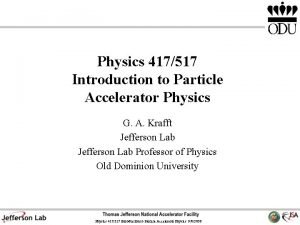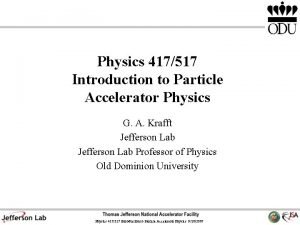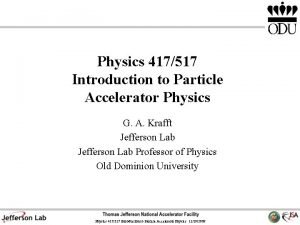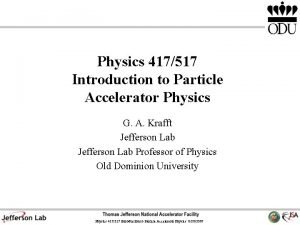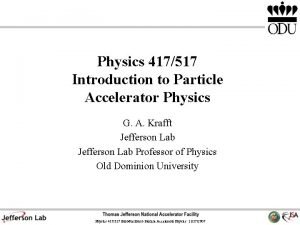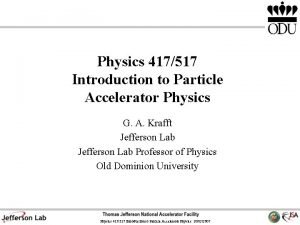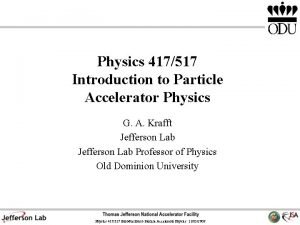Physics 417517 Introduction to Particle Accelerator Physics G



















- Slides: 19

Physics 417/517 Introduction to Particle Accelerator Physics G. A. Krafft Jefferson Lab Professor of Physics Old Dominion University Physics 417/517 Introduction to Particle Accelerator Physics 10/15/2009

Phase Advance of a Unimodular Matrix Any two-by-two unimodular (Det (M) = 1) matrix with |Tr M| < 2 can be written in the form The phase advance of the matrix, μ, gives the eigenvalues of the matrix λ = e±iμ, and cos μ = (Tr M)/2. Furthermore βγ–α 2=1 Pf: The equation for the eigenvalues of M is Physics 417/517 Introduction to Particle Accelerator Physics 10/15/2009

Because M is real, both λ and λ* are solutions of the quadratic. Because For |Tr M| < 2, λ λ* =1 and so λ 1, 2 = e±iμ. Consequently cos μ = (Tr M)/2. Now the following matrix is trace-free. Physics 417/517 Introduction to Particle Accelerator Physics 10/15/2009

Simply choose and the sign of μ to properly match the individual matrix elements with β > 0. It is easily verified that βγ – α 2 = 1. Now and more generally Physics 417/517 Introduction to Particle Accelerator Physics 10/15/2009

Therefore, because sin and cos are both bounded functions, the matrix elements of any power of M remain bounded as long as |Tr (M)| < 2. NB, in some beam dynamics literature it is (incorrectly!) stated that the less stringent |Tr (M)| 2 ensures boundedness and/or stability. That equality cannot be allowed can be immediately demonstrated by counterexample. The upper triangular or lower triangular subgroups of the two-by-two unimodular matrices, i. e. , matrices of the form clearly have unbounded powers if |x| is not equal to 0. Physics 417/517 Introduction to Particle Accelerator Physics 10/15/2009

Significance of matrix parameters Another way to interpret the parameters α, β, and γ, which represent the unimodular matrix M (these parameters are sometimes called the Twiss parameters or Twiss representation for the matrix) is as the “coordinates” of that specific set of ellipses that are mapped onto each other, or are invariant, under the linear action of the matrix. This result is demonstrated in Thm: For the unimodular linear transformation with |Tr (M)| < 2, the ellipses Physics 417/517 Introduction to Particle Accelerator Physics 10/15/2009

are invariant under the linear action of M, where c is any constant. Furthermore, these are the only invariant ellipses. Note that theorem does not apply to ±I, because |Tr (±I)| = 2. Pf: The inverse to M is clearly By the ellipse transformation formulas, for example Physics 417/517 Introduction to Particle Accelerator Physics 10/15/2009

Similar calculations demonstrate that α' = α and γ' = γ. As det (M) = 1, c' = c, and therefore the ellipse is invariant. Conversely, suppose that an ellipse is invariant. By the ellipse transformation formula, the specific ellipse is invariant under the transformation by M only if Physics 417/517 Introduction to Particle Accelerator Physics 10/15/2009

i. e. , if the vector is ANY eigenvector of TM with eigenvalue 1. All possible solutions may be obtained by investigating the eigenvalues and eigenvectors of TM. Now i. e. , Therefore, M generates a transformation matrix TM with at least one eigenvalue equal to 1. For there to be more than one solution with λ = 1, Physics 417/517 Introduction to Particle Accelerator Physics 10/15/2009

and we note that all ellipses are invariant when M = ±I. But, these two cases are excluded by hypothesis. Therefore, M generates a transformation matrix TM which always possesses a single nondegenerate eigenvalue 1; the set of eigenvectors corresponding to the eigenvalue 1, all proportional to each other, are the only vectors whose components (γi, αi, βi) yield equations for the invariant ellipses. For concreteness, compute that eigenvector with eigenvalue 1 normalized so βiγi – αi 2 = 1 All other eigenvectors with eigenvalue 1 have some value c. Physics 417/517 Introduction to Particle Accelerator Physics 10/15/2009 , for

Because Det (M) =1, the eigenvector invariant ellipse clearly yields the Likewise, the proportional eigenvector ellipse generates the similar Because we have enumerated all possible eigenvectors with eigenvalue 1, all ellipses invariant under the action of M, are of the form Physics 417/517 Introduction to Particle Accelerator Physics 10/15/2009

To summarize, this theorem gives a way to tie the mathematical representation of a unimodular matrix in terms of its α, β, and γ, and its phase advance, to the equations of the ellipses invariant under the matrix transformation. The equations of the invariant ellipses when properly normalized have precisely the same α, β, and γ as in the Twiss representation of the matrix, but varying c. Finally note that throughout this calculation c acts merely as a scale parameter for the ellipse. All ellipses similar to the starting ellipse, i. e. , ellipses whose equations have the same α, β, and γ, but with different c, are also invariant under the action of M. Later, it will be shown that more generally is an invariant of the equations of transverse motion. Physics 417/517 Introduction to Particle Accelerator Physics 10/15/2009

Applications to transverse beam optics When the motion of particles in transverse phase space is considered, linear optics provides a good first approximation of the transverse particle motion. Beams of particles are represented by ellipses in phase space (i. e. in the (x, x') space). To the extent that the transverse forces are linear in the deviation of the particles from some predefined central orbit, the motion may analyzed by applying ellipse transformation techniques. Transverse Optics Conventions: positions are measured in terms of length and angles are measured by radian measure. The area in phase space divided by π, ε, measured in m-rad, is called the emittance. In such applications, α has no units, β has units m/radian. Codes that calculate β, by widely accepted convention, drop the per radian when reporting results, it is implicit that the units for x' are radians. Physics 417/517 Introduction to Particle Accelerator Physics 10/15/2009

Linear Transport Matrix Within a linear optics description of transverse particle motion, the particle transverse coordinates at a location s along the beam line are described by a vector If the differential equation giving the evolution of x is linear, one may define a linear transport matrix Ms', s relating the coordinates at s' to those at s by Physics 417/517 Introduction to Particle Accelerator Physics 10/15/2009

From the definitions, the concatenation rule Ms'', s = Ms'', s' Ms', s must apply for all s' such that s < s'' where the multiplication is the usual matrix multiplication. Pf: The equations of motion, linear in x and dx/ds, generate a motion with for all initial conditions (x(s), dx/ds(s)), thus Ms'', s = Ms'', s' Ms', s. Clearly Ms, s = I. As is shown next, the matrix Ms', s is in general a member of the unimodular subgroup of the general linear group. Physics 417/517 Introduction to Particle Accelerator Physics 10/15/2009

Ellipse Transformations Generated by Hill’s Equation The equation governing the linear transverse dynamics in a particle accelerator, without acceleration, is Hill’s equation* Eqn. (2) The transformation matrix taking a solution through an infinitesimal distance ds is * Strictly speaking, Hill studied Eqn. (2) with periodic K. It was first applied to circular accelerators which had a periodicity given by the circumference of the machine. It is a now standard in the field of beam optics, to still refer to Eqn. 2 as Hill’s equation, even in cases, as in linear accelerators, where there is no periodicity. Physics 417/517 Introduction to Particle Accelerator Physics 10/15/2009

Suppose we are given the phase space ellipse at location s, and we wish to calculate the ellipse parameters, after the motion generated by Hill’s equation, at the location s + ds Because, to order linear in ds, Det Ms+ds, s = 1, at all locations s, ε' = ε, and thus the phase space area of the ellipse after an infinitesimal displacement must equal the phase space area before the displacement. Because the transformation through a finite interval in s can be written as a series of infinitesimal displacement transformations, all of which preserve the phase space area of the transformed ellipse, we come to two important conclusions: Physics 417/517 Introduction to Particle Accelerator Physics 10/15/2009

1. The phase space area is preserved after a finite integration of Hill’s equation to obtain Ms', s, the transport matrix which can be used to take an ellipse at s to an ellipse at s'. This conclusion holds generally for all s' and s. 2. Therefore Det Ms', s = 1 for all s' and s, independent of the details of the functional form K(s). (If desired, these two conclusions may be verified more analytically by showing that may be derived directly from Hill’s equation. ) Physics 417/517 Introduction to Particle Accelerator Physics 10/15/2009

Evolution equations for the α, β functions The ellipse transformation formulas give, to order linear in ds So Physics 417/517 Introduction to Particle Accelerator Physics 10/15/2009
 Erik adli
Erik adli Medical particle accelerator
Medical particle accelerator Bugorski
Bugorski Physics
Physics Pmt particle physics
Pmt particle physics Mark thomson particle physics
Mark thomson particle physics Particle physics
Particle physics Particle physics practice quiz
Particle physics practice quiz Particle physics timeline
Particle physics timeline Monte carlo simulation particle physics
Monte carlo simulation particle physics Cern particle physics
Cern particle physics European laboratory for particle physics
European laboratory for particle physics Cern particle physics
Cern particle physics Particle physics
Particle physics Form factor particle physics
Form factor particle physics International masterclasses hands on particle physics
International masterclasses hands on particle physics Transformational leadership questionnaire
Transformational leadership questionnaire Accelerator theory of investment
Accelerator theory of investment Swift biz
Swift biz Netbackup track log location
Netbackup track log location
